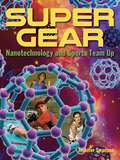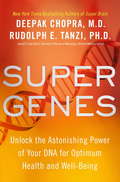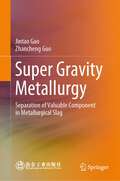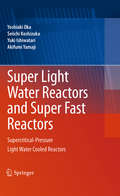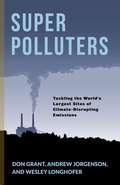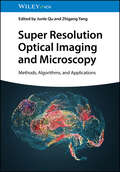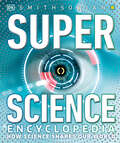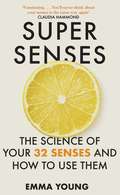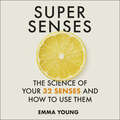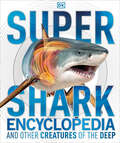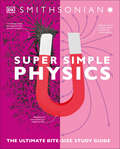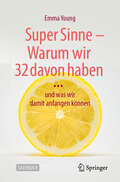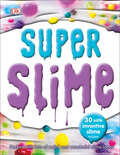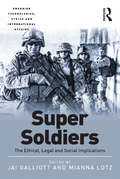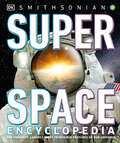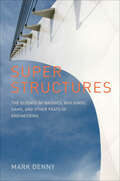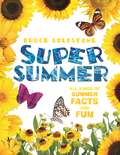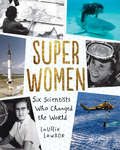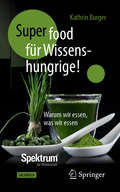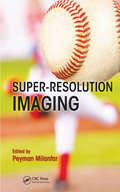- Table View
- List View
Super Gear: Nanotechnology and Sports Team Up
by Jennifer SwansonCutting-edge science; high-performance sports How are the sports played by Michael Phelps, Serena Williams, Michelle Wie, and Usain Bolt related? Nanotechnology! Take a close-up look at sports and nanotechnology, the cutting-edge science that manipulates objects at the atomic level. Nanotechnology is used to create high-tech swimsuits, tennis rackets, golf clubs, running shoes, and more. It is changing the face of sports as we know it. Back matter includes a glossary, bibliography, list of resources, and index. Perfect for 2016 Summer Olympics displays and celebrations.
Super Genes
by Deepak Chopra Rudolph E. TanziThe authors of the New York Times bestseller Super Brain present a bold new understanding of our genes and how simple changes in lifestyle can boost genetic activity. The leap into "radical well-being" is a promise waiting to be fulfilled. "You are not simply the sum total of the genes you were born with," writes Deepak Chopra and Rudy Tanzi. "You are the user and controller of your genes, the author of your biological story. No prospect in self-care is more exciting." Learning how to shape your gene activity is at the heart of this exciting and eagerly-anticipated book from the bestselling duo behind Super Brain, which became a nationwide hit on public television. For decades medical science has believed that genes determined our biological destiny. Now the new genetics has changed that assumption forever. You will always have the genes you were born with, but genes are dynamic, responding to everything we think, say, and do. Suddenly they've become our strongest allies for personal transformation. When you make lifestyle choices that optimize how your genes behave, you can reach for a state of health and fulfillment undreamed of even a decade ago. The impact on prevention, immunity, diet, aging, and chronic disorders is unparalleled.
Super Genes: Unlock the Astonishing Power of Your DNA for Optimum Health and Well-Being
by Deepak Chopra Rudolph E. TanziThe authors of the New York Times bestseller Super Brain present a bold new understanding of our genes and how simple changes in lifestyle can boost genetic activity. The leap into "radical well-being" is a promise waiting to be fulfilled. "You are not simply the sum total of the genes you were born with," writes Deepak Chopra and Rudy Tanzi. "You are the user and controller of your genes, the author of your biological story. No prospect in self-care is more exciting." Learning how to shape your gene activity is at the heart of this exciting and eagerly-anticipated book from the bestselling duo behind Super Brain, which became a nationwide hit on public television. For decades medical science has believed that genes determined our biological destiny. Now the new genetics has changed that assumption forever. You will always have the genes you were born with, but genes are dynamic, responding to everything we think, say, and do. Suddenly they've become our strongest allies for personal transformation. When you make lifestyle choices that optimize how your genes behave, you can reach for a state of health and fulfillment undreamed of even a decade ago. The impact on prevention, immunity, diet, aging, and chronic disorders is unparalleled.
Super Genes: Unlock the Astonishing Power of Your DNA for Optimum Health and Well-Being
by Deepak Chopra Rudolph E. TanziThe authors of the New York Times bestseller Super Brain present a bold new understanding of our genes and how simple changes in lifestyle can boost genetic activity. The leap into "radical well-being" is a promise waiting to be fulfilled. "You are not simply the sum total of the genes you were born with," writes Deepak Chopra and Rudy Tanzi. "You are the user and controller of your genes, the author of your biological story. No prospect in self-care is more exciting." Learning how to shape your gene activity is at the heart of this exciting and eagerly-anticipated book from the bestselling duo behind Super Brain, which became a nationwide hit on public television. For decades medical science has believed that genes determined our biological destiny. Now the new genetics has changed that assumption forever. You will always have the genes you were born with, but genes are dynamic, responding to everything we think, say, and do. Suddenly they've become our strongest allies for personal transformation. When you make lifestyle choices that optimize how your genes behave, you can reach for a state of health and fulfillment undreamed of even a decade ago. The impact on prevention, immunity, diet, aging, and chronic disorders is unparalleled.
Super Gravity Metallurgy: Separation of Valuable Component in Metallurgical Slag
by Zhancheng Guo Jintao GaoThis book introduces super gravity metallurgy in separation of valuable component in metallurgical slag. It collects the principle, apparatus and research for super gravity high-temperature metallurgy and the novel technology for selective crystallization and separation of various valuable components in different metallurgical slags by super gravity. Furthermore, the research results previously scattered in many journals and conferences worldwide are methodically edited and presented in a unified form. The book is likely to be of interest to university teachers, researchers, R&D engineers and graduate students in pyrometallurgy and extractive metallurgy who wish to explore innovative methods and technologies that lead to more efficient and environmentally sustainable utilization of metallurgical slag.
Super Light Water Reactors and Super Fast Reactors
by Akifumi Yamaji Yuki Ishiwatari Seiichi Koshizuka Yoshiaki OkaSuper Light Water Reactors and Super Fast Reactors provides an overview of the design and analysis of nuclear power reactors. Readers will gain the understanding of the conceptual design elements and specific analysis methods of supercritical-pressure light water cooled reactors. Nuclear fuel, reactor core, plant control, plant stand-up and stability are among the topics discussed, in addition to safety system and safety analysis parameters. Providing the fundamentals of reactor design criteria and analysis, this volume is a useful reference to engineers, industry professionals, and graduate students involved with nuclear engineering and energy technology.
Super Marsupials: Kangaroos, Koalas, Wombats, and More (Let's-Read-and-Find-Out Science 1)
by Katharine KenahRead and find out about marsupials—amazing kangaroos, tree kangaroos, koalas, Tasmanian devils, wombats, opossums, and sugar gliders—in this colorfully illustrated nonfiction picture book.Animals that keep their babies in soft, furry pouches are called marsupials. There are many sorts of marsupials, and they all have super amazing qualities.This book comes with a colorful infographic and an activity called Joey Day all about what it would be like to carry a marsupial joey (which means baby!) around all day long.This is a clear and appealing science book for early elementary age kids, both at home and in the classroom. It's a Level 1 Let's-Read-and-Find-Out, which means the book explores introductory concepts perfect for children in the primary grades. The 100+ titles in this leading nonfiction series are:hands-on and visualacclaimed and trustedgreat for classroomsTop 10 reasons to love LRFOs:Entertain and educate at the same timeHave appealing, child-centered topicsDevelopmentally appropriate for emerging readersFocused; answering questions instead of using survey approachEmploy engaging picture book quality illustrationsUse simple charts and graphics to improve visual literacy skillsFeature hands-on activities to engage young scientistsMeet national science education standardsWritten/illustrated by award-winning authors/illustrators & vetted by an expert in the fieldOver 130 titles in print, meeting a wide range of kids' scientific interestsBooks in this series support the Common Core Learning Standards, Next Generation Science Standards, and the Science, Technology, Engineering, and Math (STEM) standards. Let's-Read-and-Find-Out is the winner of the American Association for the Advancement of Science/Subaru Science Books & Films Prize for Outstanding Science Series.
Super Polluters: Tackling the World’s Largest Sites of Climate-Disrupting Emissions (Society and the Environment)
by Wesley Longhofer Don Grant Andrew JorgensonPower plants are essential to achieving the standard of living that modern societies demand and the social and economic infrastructure on which they depend. Yet their indispensability has allowed them to evade responsibility for their vast carbon emissions. Fossil-fueled power plants are the single largest sites of anthropogenic greenhouse gases, making them one of the greatest threats to our planet’s climate. Significant as they are, we lack a comprehensive understanding of the social causes that enable power plant emissions and continue to delay their reduction.Super Polluters offers a groundbreaking global analysis of carbon pollution caused by the generation of electricity, pinpointing who bears the most responsibility for the energy sector’s vast emissions and what can be done about them. The sociologists Don Grant, Andrew Jorgenson, and Wesley Longhofer analyze a novel dataset on the carbon dioxide emissions and structural attributes of thousands of fossil-fueled power plants around the world, identifying which plants discharge the most carbon. They investigate the global, organizational, and political conditions that explain these hyper-emitting facilities’ behavior and call into question the claim that improvements in technical efficiency will always reduce emissions. Grant, Jorgenson, and Longhofer demonstrate which energy and climate policies are most effective at abating power-plant pollution, emphasizing how mobilized citizen activism shapes those outcomes. A comprehensive account of who bears the blame for our warming planet, Super Polluters points to more feasible and effective emission reduction strategies that target the world’s most profligate polluters.
Super Resolution Optical Imaging and Microscopy: Methods, Algorithms, and Applications
by Junle Qu Zhigang YangSuper Resolution Optical Imaging and Microscopy Extremely comprehensive resource containing cutting-edge and practical knowledge of super-resolution optical imaging This book covers both the basic principles and specific technical details of super-resolution microscopy techniques. It covers the criteria to choose different fluorophores for various SRM methods and critically assesses the nitty-gritty of associated problems that are often encountered in practical applications. A progressive guide to designing the next generation of advanced fluorophores to meet the goal of advanced SR imaging studies is also put forward. Written by two well-qualified authors, the book contains exclusive content to enhance readers’ understanding on innovation of newer SRM technologies. Sample topics covered in the book include: Optical techniques, fluorescent probe design, and algorithm development Recent highlight and breakthroughs in biology using SRM methods The overall success of SRM in biological inventions The future direction and scope of the field This book is an invaluable resource for chemists and researchers/scientists involved in designing newer fluorescent materials for SRM studies. It can also assist biologists engaged in advanced biological studies using SRM by guiding them through sample preparation, image processing, and precautions to be taken in practical imaging studies.
Super Science Encyclopedia: How Science Shapes Our World (DK Super Nature Encyclopedias)
by DKPut your safety goggles on and enter the fascinating world of science with this visually stunning encyclopedia.Presenting the wonders of science as never seen before, from the latest technologies for breathing underwater and growing food in space, to the advances in medicines and robotics. Explore groundbreaking scientific achievements, and think beyond basic biology, chemistry and physics. Here&’s what you&’ll find inside: • An encyclopedia-type reference book that engages and excites young minds to think about many different scientific fields. • Lively, informative and accessible text based on the latest discoveries and scientific research. • Dashboard-style graphic panels provide information at a glance. Help mould young scientific mindsThis science book for kids is perfect for children age 9 and up, and for anyone who loves to learn about the latest in science and technology. It includes jaw-dropping photography and revealing computer-generated images to supplement the interesting facts, information and diagrams. SuperScience examines the science behind everyday life and the technologies that allow us to create the world previously only imagined in science fiction. It features a wide range of scientific inventions that help us solve modern problems like climate change and global pandemics. More in the series!Our Super series has a range of superb visual encyclopedias for the young and the curious, with an array of stunning illustrations covering many fascinating topics. Complete your collection with SuperNature, SuperHuman, SuperShark, SuperBug or SuperEarth.
Super Senses: The Science of Your 32 Senses and How to Use Them
by Emma YoungHow do you sniff out danger? What is a sense of direction or a gut instinct? You know about your five senses: hearing, sight, smell, taste and touch. But recent research has shown that we actually have at least thirty-two. We take our senses for granted but what would be possible if we properly understood how they all work? Award-winning science writer Emma Young has spent over a decade finding out, and in Super Senses she takes us on an exhilarating sensory journey, revealing how we taste things without using our tongues, why swearing is good for us and why both chocolate and rollercoasters can help you fall in love.Using the very latest cutting-edge research, she explains the exploits of record-breaking freedivers, whirling dervishes, super-tasters, stock market millionaires, and many more. Discover how touch can ease pain, how taking your pulse can make you fitter and why Abba's Dancing Queen sounds different in Bolivia. Sharing surprising secrets from blind ballerinas, voodoo priests and even a nurse who can smell Parkinson's disease before it is diagnosed, Super Senses uncovers the science behind these abilities that make us human - and offers fascinating lessons in how we can all learn to use them better. Could being more sensitive make us happier, healthier - or even wealthier?
Super Senses: The Science of Your 32 Senses and How to Use Them
by Emma YoungA mind-bending, eye-opening scientific exploration of our senses - all 32 of them.How do you sniff out danger? What is a sense of direction or a gut instinct? You know about your five senses: hearing, sight, smell, taste and touch. But recent research has shown that we actually have at least thirty-two. We take our senses for granted but what would be possible if we properly understood how they all work? Award-winning science writer Emma Young has spent over a decade finding out, and in Super Senses she takes us on an exhilarating sensory journey, revealing how we taste things without using our tongues, why swearing is good for us and why both chocolate and rollercoasters can help you fall in love.Using the very latest cutting-edge research, she explains the exploits of record-breaking freedivers, whirling dervishes, super-tasters, stock market millionaires, and many more. Discover how touch can ease pain, how taking your pulse can make you fitter and why Abba's Dancing Queen sounds different in Bolivia. Sharing surprising secrets from blind ballerinas, voodoo priests and even a nurse who can smell Parkinson's disease before it is diagnosed, Super Senses uncovers the science behind these abilities that make us human - and offers fascinating lessons in how we can all learn to use them better. Could being more sensitive make us happier, healthier - or even wealthier?(P) 2021 Hodder & Stoughton Ltd
Super Shark Encyclopedia: And Other Creatures of the Deep (DK Super Nature Encyclopedias)
by DKA jaw-dropping visual voyage of fun facts discovery exploring the deep waters of the sea and the mysterious creatures that live in it.Uncover our oceans' secrets in this kid's book with a remarkable array of 80 sharks as well as other fascinating sea creatures that lurk in her depths! This comprehensive encyclopedia for children covers a diverse range of ocean inhabitants in mesmerizing detail.Incredible 3D digital images, breath-taking photography, and intricate cutaways reveal more about the species of the ocean depths than ever before, complemented by informative kid-friendly profile text to turn your little ones into ocean experts!Super Shark is so much more than just an educational book about sharks. From Barrel Shrimp to Blue Sharks, Starfish to Bat Fish, and Hammerhead Sharks to deep-sea monsters, rays, and eels, this book is packed with unbelievable facts about animal behavior and anatomy. New x-ray artworks utilize cross-sections to strip layers away and show key anatomical features in great detail. It highlights the deadliest predators and the most venomous creatures and explains how and why their bodies work the way they do. The combination of spectacular photography and clear authoritative text truly makes Super Shark the ultimate visual guide to the oceans' most peculiar creatures and their stories.What are you waiting for? Dive in and become an expert of the deep blue! Explore – Discover – Learn!Super Shark takes you deep beneath the waves to meet some of the most amazing and unusual creatures on the planet. Find out how a hammerhead searches for prey, and discover what makes the pufferfish such a prickly fellow. Learn about the fastest fish in the water and get right under the skin of one of the deadliest predators of the sea - the great white shark!These are some of the crazy creatures you'll encounter in this kid's reference book: - The Basking Shark, whose open mouth is so big a child could stand up in it- The Tiger Shark, who happens to be the least fussy eater- The Narwhal, affectionately known as the unicorn of the sea- The Great White Shark, who can jump 10ft (3m) out of the waterThis book sits on the esteemed "Children's Book Council Children's Choices List Selection" - an International Literary Association. This is but one of the DK Super series of books for kids! Add Super Human, Super Space, Super Bug, Super Earth, and more to your collection to learn more about the world around you.
Super Simple Experiments with Forces: Fun and Innovative Science Projects (SUPER SIMPLE SCIENCE aT WORK)
by Paige V. PolinskySUPER SIMPLE SCIENCE AT WORK Become a scientist with Super Simple Experiments with Forces! Learn all about forces, and then put your knowledge to use with fun experiments. Make a parachute to test the force of gravity, magically move a mini boat with surface tension, and more. Each experiment has easy-to-read directions paired with step-by-step photographs, while colorful graphics describe the super cool science at work. It’s time to grab your lab coat and have fun experimenting!
Super Simple Physics: The Ultimate Bitesize Study Guide (DK Super Simple)
by DKCrammed with fascinating facts and all the core curriculum topics, this physics book will have you exam-ready in no time!Created in association with the Smithsonian Institution, this completely comprehensive guide makes physics crystal clear. It&’s the perfect support for home and school learning.This super simple science book cuts through the jargon and breaks down the information into easy, manageable chunks. From atoms and states of matter to scalars and vectors, this indispensable guide is packed with everything you need to quickly and easily understand physics.The Ultimate Physics Revision Book Every page is designed to make even the most complex scientific subjects accessible and engaging. Topics are covered in one easy-to-follow single page and fully illustrated to explain the concept - perfect for visual learners. The essential points are in a Key Facts box, which is great for checking back later when revising. Calculations and graphs are set out in simple, logical steps to make the science feel achievable for all students.Whether you&’re a keen physicist or just looking to get an A+,, this accessible science revision guide for children offers clear and concise coverage of all the core physics topics. From dramatic images of planets to bolts of lightning, vivid photography makes it easy for students to relate physics to the world around them.Complete the Series:Alongside SuperSimple: Chemistry, SuperSimple: Biology, and SuperSimple: Maths, these revision guides are part of an exciting new series designed not only to educate, but to inspire.
Super Sinne - Warum wir 32 davon haben: … und was wir damit anfangen können
by Emma YoungWie viele Sinne hat der Mensch? Die klassischen fünf? Oder sechs? Oder sieben? Vielleicht noch mehr? Jüngste Forschungen haben gezeigt, dass wir eigentlich mindestens 32 Sinne haben. Die preisgekrönte Wissenschaftsautorin Emma Young nimmt uns mit auf eine aufregende sensorische Reise und verrät, wie wir Dinge schmecken, ohne unsere Zunge zu benutzen, warum Fluchen gut für uns ist und warum sowohl Schokolade als auch Achterbahnen uns helfen können, uns zu verlieben. Sie zeigt, wie Berührungen Schmerzen lindern, wie das Messen des Pulses uns fitter macht und warum ABBAs Dancing Queen in Bolivien anders klingt. Supersinne enthüllt die Wissenschaft, die hinter Fähigkeiten von blinden Ballerinas, Vodoo Priesteren und einer Krankenschwester, die Parkinson riechen kann, bevor die Krankheit diagnostiziert wird, steckt. Wie können wir alle lernen, unsere Sinne besser zu nutzen? Kann mehr Sensibilität uns glücklicher, gesünder oder gar reicher machen? In diesem Buch finden Sie die Antworten.
Super Slime: 30 Safe and Inventive Slime Recipes
by DKThe most incredible and gooiest trend that&’s taking the internet by storm – Slime! This activity ebook for kids contains over 30 squishy innovative recipes that are gross, sparkly, even smelly, for lots of fun! Learn everything you'll need to know about slime-making. Take inexpensive, accessible, safe materials and turn them into a fun day of crafting with a kids&’ activity ebook perfect for all ages. Customize incredible Halloween and Christmas-themed slimes, set off a slime avalanche, and create slime from unexpected everyday ingredients such as a banana and even toothpaste.Slime is so versatile!Every project is easy to follow, with detailed step-by-step instructions, photographs, and spectacular images to show you what your "slimelicious" final product should look like. Recipe variations provide an opportunity to put your own fun twist on the activities and information boxes explain the science behind the slime with astonishing fun facts to boot.Children will adore making and playing with these super slimes. Warning - playing with this squidgy, gloopy, gooey substance is incredibly addictive, no matter how old you are!Right from the get-go Super Slime lists the inexpensive ingredients you&’ll need to work through the book. Each slime recipe also comes with a time expectation on how long it should take and a difficulty level so you can plan your crafting accordingly.As a bonus, it comes with a great section on storage, clean-up, and some extra hints and tips for more fun! Get Gross, Sparkly, Or Festive!Each recipe in Super Slime is thoroughly tested and uses safe, accessible ingredients. With so many options and vast variations online, it's comforting to know that your slime will come out perfect every time! Enjoy creating some of this spectacularly squishy stuff:- Slime you can draw on- Playdough slime- Slime stress balls- Color changing slime- And much, much more!Start making slime today!This ebook is one of two slimetastic titles in the DK collection! Try The Slime Book next, packed with another 30 wonderful recipes your little ones will love to try - it's got some edible recipes too!
Super Soldiers: The Ethical, Legal and Social Implications (Emerging Technologies, Ethics and International Affairs)
by Jai Galliott Mianna LotzThe Spartan City State produced what is probably one of the most iconic and ruthless military forces in recorded history. They believed that military training and education began at birth. Post-World War II saw a shift to army tanks, fighter jets and missiles that would go on to fight the next huge battle in Northern Europe. Today, with the advent of unmanned systems, our hopes are attached to the idea that we can fight our battles with soldiers pressing buttons in distant command centres. However, soldiers must now be highly trained, super strong and have the intelligence and mental capacity to handle the highly complex and dynamic military operating environment. It is only now as we progress into the twenty-first century that we are getting closer to realising the Spartan ideal and creating a soldier that can endure more than ever before. This book provides the first comprehensive and unifying analysis of the moral, legal and social questions concerning military human enhancement, with a view toward developing guidance and policy that may influence real-world decision making.
Super Space Encyclopedia: The Furthest, Largest, Most Spectacular Features of Our Universe (DK Super Nature Encyclopedias)
by DKExplore our wonderful universe through stunning CGI illustrations and amazing stats that bring to life the incredible marvels that populate space.Bursting with fascinating facts and the latest breathtaking images, this space book for children brings the wonders of the Solar System to life. Find out about the never-ending storms on Jupiter. Learn about the towering volcanoes of Venus - all 1,600 of them, and see the Valles Marineris on Mars--a canyon that is ten times longer than Earth's Grand Canyon. Find out many more fascinating "super" facts about the cosmos with Super Space Encyclopedia. Based on recent research and discoveries, Super Space Encyclopedia showcases everything you need to know about the Universe--from the Big Bang to the formation of galaxies and planets as well as the technology used to explore it unimaginable depths. Fabulous cutaway artworks help to reveal the inner workings of the Sun, planets, and spacecraft. Super Space Encyclopedia brings the cosmos to life in a visually compelling and informative way, making it a must-have book for every budding space enthusiast.
Super Structures: The Science of Bridges, Buildings, Dams, and Other Feats of Engineering
by Mark DennyEver wonder how a graceful and slender bridge can support enormous loads over truly astonishing spans? Why domes and free-standing arches survive earthquakes that flatten the rest of a city?Physicist Mark Denny looks at the large structures around us—tall buildings, long bridges, and big dams—and explains how they were designed and built and why they sometimes collapse, topple, or burst. Denny uses clear, accessible language to explain the physics behind such iconic structures as the Parthenon, the Eiffel Tower, the Forth Rail Bridge in Edinburgh, and Hoover Dam. His friendly approach allows readers to appreciate the core principles that keep these engineering marvels upright without having to master complex mathematical equations. Employing history, humor, and simple physics to consider such topics as when to use screws or nails, what trusses are, why iron beams are often I-shaped, and why medieval cathedrals have buttresses, Denny succeeds once again in making physics fun.
Super Structures: The Science of Bridges, Buildings, Dams, and Other Feats of Engineering
by Mark DennyAn “extraordinary guide to the hidden secrets of modern man-made miracles . . . Highly recommended” —from the author of Froth!: The Science of Beer (Midwest Book Review).Ever wonder how a graceful and slender bridge can support enormous loads over truly astonishing spans? Why domes and free-standing arches survive earthquakes that flatten the rest of a city?Physicist Mark Denny looks at the large structures around us—tall buildings, long bridges, and big dams—and explains how they were designed and built and why they sometimes collapse, topple, or burst.Denny uses clear, accessible language to explain the physics behind such iconic structures as the Parthenon, the Eiffel Tower, the Forth Rail Bridge in Edinburgh, and Hoover Dam. His friendly approach allows readers to appreciate the core principles that keep these engineering marvels upright without having to master complex mathematical equations.Employing history, humor, and simple physics to consider such topics as when to use screws or nails, what trusses are, why iron beams are often I-shaped, and why medieval cathedrals have buttresses, Denny succeeds once again in making physics fun.Praise for Mark Denny“Denny’s wry humor is fun to read and made me laugh out loud.” —Mark Kidger, author of Astronomical Enigmas“Denny largely sheds the complexity of mathematical constructs, distilling their most salient features into a more qualitative understanding of radar and sonar systems.” —Choice“Indeed, Denny’s writing is anything but dry and boring. He adeptly explains complex subject matter and does so with relatively simple language and minimal use of symbolic notation.” —Bat Research News
Super Summer: All Kinds of Summer Facts and Fun (Season Facts and Fun)
by Bruce GoldstoneSummer is a season of plenty—plenty of sun and fun. People take vacations and find plenty of activities in and around water. Animals try to stay cool, while bees and wasps go to work. Flowers bloom and fruits and vegetables ripen. Get ready to explore summer's amazing abundance!With vivid photographs, lively explanations, and creative craft ideas, Bruce Goldstone's Super Summer presents all the fascinating facts that make summer so super in his fourth and final picture book about the seasons.
Super Women: Six Scientists Who Changed the World
by Laurie Lawlor"Inspiring profiles of six 20th-century trailblazers."—Kirkus ReviewsSuper Women celebrates the scientific as well as the social significance of six incredible women who broke new ground with their research, busted through glass ceilings with their careers, and advanced humanity's understanding of our world in the process. These amazing women defied prejudice to succeed in the sciences using genius, ambition, and perseverance:Katherine Coleman Johnson, a mathematician who calculated trajectories for NASA flights and is one of the women showcased in the award-winning feature film, Hidden FiguresEugenie Clark, an ichthyologist who swam with sharksMarie Tharp, a cartographer who mapped the ocean floorFlorence Hawley Ellis, an anthropologist of Pueblo cultures who pioneered tree-ring datingGertrude Elion, a Noble Prize-winning pharmacologist who developed treatments for leukemia and AIDSMargaret Burbidge, an astrophysicist who formulated a theory of quasars and helped create the Hubble telescopeALA Notable Book author Laurie Lawlor deftly paints portraits of each of these pioneers who refused to take no for an answer, pursuing their passions through fieldwork, observations, laboratories, and research vessels in the face of sexism. This diverse group of women, all with awe-inspiring accomplishments, were active mentors and determined people who wouldn’t take no for an answer.The beautifully written book includes key photographs, a glossary, and source notes—and is truly an important book for our time.A 2018 NSTA-CBC Outstanding Science Trade Book for Students K-12!
Super-Food für Wissenshungrige!: Warum wir essen, was wir essen
by Kathrin BurgerVeganismus, Steinzeitkost, Clean Eating – Spezial-Diäten sind beliebt. Ob sie auch gesund sind, erfahren sie in diesem Buch, einer Sammlung aus 27 allgemein verständlichen Beiträgen aus Spektrum der Wissenschaft und spektrum.de . Klar ist, dass nicht zu viele stark verarbeitete Fertigprodukte auf dem Tisch stehen sollten. Doch Ernährung ist viel mehr als die Summe der Inhaltsstoffe in den verzehrten Lebensmitteln. Essen ist ein „kulturelles Totalphänomen“. Das heißt, es spielen psychische sowie gesellschaftliche Faktoren eine große Rolle dabei, was wir essen. Darum essen Männer auch etwas anderes als Frauen, darum unterscheiden sich Speisepläne auf der ganzen Welt und darum werden Ess-Entscheidungen großteils nicht mit dem Verstand sondern mit dem Gefühl getroffen. Genießen Sie also die hier aufgetischten Fakten und stillen Sie Ihren Wissenshunger.
Super-Resolution Imaging (Digital Imaging and Computer Vision)
by Peyman MilanfarWith the exponential increase in computing power and broad proliferation of digital cameras, super-resolution imaging is poised to become the next "killer app." The growing interest in this technology has manifested itself in an explosion of literature on the subject. Super-Resolution Imaging consolidates key recent research contributions from eminent scholars and practitioners in this area and serves as a starting point for exploration into the state of the art in the field. It describes the latest in both theoretical and practical aspects of direct relevance to academia and industry, providing a base of understanding for future progress. Features downloadable tools to supplement material found in the book Recent advances in camera sensor technology have led to an increasingly larger number of pixels being crammed into ever-smaller spaces. This has resulted in an overall decline in the visual quality of recorded content, necessitating improvement of images through the use of post-processing. Providing a snapshot of the cutting edge in super-resolution imaging, this book focuses on methods and techniques to improve images and video beyond the capabilities of the sensors that acquired them. It covers: History and future directions of super-resolution imaging Locally adaptive processing methods versus globally optimal methods Modern techniques for motion estimation How to integrate robustness Bayesian statistical approaches Learning-based methods Applications in remote sensing and medicine Practical implementations and commercial products based on super-resolution The book concludes by concentrating on multidisciplinary applications of super-resolution for a variety of fields. It covers a wide range of super-resolution imaging implementation techniques, including variational, feature-based, multi-channel, learning-based, locally adaptive, and nonparametric methods. This versatile book can be used as the basis for short courses for engineers and scientists, or as part of graduate-level courses in image processing.
